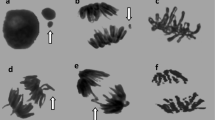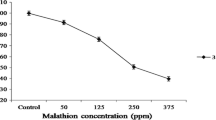Abstract
Adequate copper (Cu2+) concentrations are required for plants; however, at higher concentrations it can also cause multiple toxic effects. In the present study, lipid peroxidation, hydrogen peroxide levels as well as ascorbate peroxidase (APX: EC 1/11/1/11) and catalase (CAT: EC 1.11.1.6) activities were determined in Lycopersicum esculentum Mill. and Cucumis sativus L. seedlings after 7-day exposure to copper sulfate. In addition, DNA damage in these two crops was assessed by measuring micronucleus (MN) frequency and tail moments (TM) as determined by Comet assay. Inhibitory copper concentrations (EC50: 30 and 5.5 ppm for L. esculentum and C. sativus, respectively) were determined according to dose-dependent root inhibition curves, and EC50 and 2×EC50 were applied. Malondialdehyde (MDA) and H2O2 levels significantly increased in all groups studied. CAT activity increased in treatment groups of C. sativus. APX activity increased in L. esculentum seedlings due to 2×EC50 treatment. Reductions in mitotic indices (MI) represented Cu2+dependent root growth inhibition in all treatment groups studied. According to TMs and MN frequencies, copper exposure induced significant DNA damage (p < 0.05) in all study groups, whereas the DNA damage induced was dose dependent in C. sativus roots. In conclusion, Cu2+induced oxidative damage, elevations in H2O2 levels and alterations in APX and CAT activities, as well as significant DNA damage in nuclei of both study groups. To our knowledge, this is the first comparative and comprehensive study demonstrating the effects of copper on two different plant species at relevant cytotoxic concentrations at both biochemical and genotoxicity levels with multiple end points.





Similar content being viewed by others
References
Alloway BJ (1995) Heavy metal in soils, 2nd edn. Blackie Academic and Professional, London
Apel K, Hirt H (2004) Reactive oxygen species: metabolism, oxidative stress, and signal transduction. Annu Rev Plant Biol 55:373–399
Aust SD, Morehouse LA, Thomas CE (1985) Role of metals in oxygen radical reactions. J Free Radic Biol Med 1(1):3–25
Bernt E, Bergmeyer HU (1974) Inorganic peroxidasses. In: Bergmeyer HU (ed) Methods of enzymatic analysis. CRC Press, Boca Raton, pp 2246–2248
Bradford MM (1976) A rapid and sensitive method for the quantitation of microgram quantities of protein utilizing the principle of protein–dye binding. Anal Biochem 72:248–254
Celikkol Akcay U, Ercan O, Kavas M, Yildiz L, Yilmaz C, Oktem HA, Yucel M (2010) Drought-induced oxidative damage and antioxidant responses in peanut (Arachis hypogaea L.) seedlings. Plant Growth Regul 61(1):21–28
Chance B, Mahly AC (1995) Assay of catalases and peroxidases. Methods Enzymol 2:764–817
Chen LM, Lin CC, Kao CH (2000) Copper toxicity in rice seedlings: changes in antioxidative enzyme activities, H2O2 level, and cell wall peroxidase activity in roots. Bot Bull Acad Sin 41:99–103
Cuypers A, Vangronseld J, Clijsters H (1999) The chemical behavior of heavy metals plays a prominent role in the induction of oxidative stress. Free Rad Res 31:39–43
De Vos CHR, Schat H, Vooijs R, Ernst WAO (1989) Copper induced damage to the permeability barrier in roots of Silene cucubalus. J Plant Physiol 135:164–169
Dizdaroglu M, Jaruga P, Birincioglu M, Rodriguez H (2002) Free radical-induced damage to DNA: mechanisms and measurement. Free Radic Biol Med 32(11):1102–1115
Doncheva S, Nicolov B, Ogneva V (1996) Effect of copper excess on the morphology of the nucleus in maize root meristem cells. Physiol Plantarum 96:118–122
Ducic T, Polle A (2005) Transport and detoxification of manganese and copper in plants. Braz J Plant Physiol 17(1):103–112
Fenech M, Holland N, Chang WP, Zeiger E, Bonassi S (1999) The human micronucleus project—an international collaborative study on the use of the micronucleus technique for measuring DNA damage in humans. Mutat Res 428(1–2):271–283
Gichner T (2003) DNA damage induced by indirect and direct acting mutagens in catalase-deficient transgenic tobacco on cellular and acellular Comet assays. Mutat Res 535:187–193
Gichner T, Patková Z, Száková J, Demnerová K (2004) Cadmium induces DNA damage in tobacco roots, but no DNA damage, somatic mutations or homologous recombination in tobacco leaves. Mutat Res 559:49–57
Halliwell B, Gutteridge JM (1984) Oxygen toxicity, oxygen radicals, transition metals and disease. Biochem J 219(1):1–14
Heddle JA, Cimino MC, Hayashi M, Romagna F, Shelby MD, Tucker JD, Vanparys P, MacGregor JT (1991) Micronuclei as an index of cytogenetic damage: past, present, and future. Environ Mol Mutagen 18(4):277–291
Hernández D, Plaza C, Senesi N, Polo A (2006) Detection of copper(II) and zinc(II) binding to humic acids from pig slurry and amended soils by fluorescence spectroscopy. Environ Pollut 143(2):212–220
İnceer H, Beyazoğlu O (2000) Cytogenetic effects of copper chloride on the root tip cells of Vicia hirsuta (L). Turk J Biol 24:553–559
İnceer H, Ayaz S, Beyazoğlu O, Şentürk E (2003) Cytogenetic effects of copper chloride on the root tip cells of Helianthus annuus L. Turk J Biol 27:43–46
Körpe DA, Aras S (2011) Evaluation of copper-induced stress on eggplant (Solanum melongena L.) seedlings at the molecular and population levels by use of various biomarkers. Mutat Res 719(1–2):29–34
Lidon FC, Ramalho J, Henriques FS (1993) Copper inhibition of rice photosynthesis. J Plant Physiol 142:2–17
Lin AJ, Zhang XH, Chen MM, Cao Q (2007) Oxidative stress and DNA damages induced by cadmium accumulation. J Environ Sci 19(5):596–602
Marschner H (1995) Mineral nutrition of higher plants, 2nd edn. Academic Press, London
Mittler R (2002) Oxidative stress, antioxidants and stress tolerance. Trends Plant Sci 7:405–410
Mittler R, Vanderauwera S, Gollery M, Van Breusegem F (2004) Reactive oxygen gene network of plants. Trends Plant Sci 9(10):490–498
Mocquot B, Vangronsveld J, Clijsters H, Mench M (1996) Copper toxicity in young maize (Zea mays L.) plants: effects on growth, mineral and chlorophyll contents, and enzyme activities. Plant Soil 182(2):287–300
Neill SC, Desikan R, Hancock J (2002) Hydrogen peroxide signaling. Curr Opin Plant Biol 5:388–395
Ohkawa H, Ohishi N, Yagi K (1979) Assay for lipid peroxides in animal tissues by thiobarbituric acid reaction. Anal Biochem 95(2):351–358
Padmavathiamma PK, Li LY (2007) Phytoremediation technology: hyper-accumulation metals in plants. Water Air Soil Poll 184:105–126
Phalsson AMB (1989) Toxicity of heavy metals (Zn, Cu, Cd, Pb) to vascular plants. Water Air Soil Poll 47:287–319
Rhoads FM, Olson SM, Manning A (1989) Copper toxicity in tomato plants. J Environ Qual 18:195–197
Sayen S, Mallet J, Guillon E (2009) Aging effect on the copper sorption on a vineyard soil: column studies and SEM-EDS analysis. J Colloid Interface Sci 331(1):47–54
Seth CS, Misra V, Chauhan LKS, Singh RR (2008) Genotoxicity of cadmium on root meristem cells of Allium cepa: cytogenetic and Comet assay approach. Ecotoxicol Environ Safe 71:711–716
Singh D, Nath K, Sharma YK (2007) Response of wheat seed germination and seedling growth under copper stress. J Environ Biol 28(2):409–414
Sun BY, Kan SH, Zhang YZ, Deng SH, Wu J, Yuan H, Qi H, Yang G, Li L, Zhang XH, Xiao H, Wang YJ, Peng H, Li YW (2010) Certain antioxidant enzymes and lipid peroxidation of radish (Raphanus sativus L.) as early warning biomarkers of soil copper exposure. J Hazard Mater 183(1–3):833–838
Tolbert PE, Shy CM, Allen JW (1992) Micronuclei and other nuclear anomalies in buccal smears: methods development. Mutat Res 271:69–77
Tuteja N, Singh MB, Misra MK, Bhalla PL, Tuteja R (2001) Molecular mechanisms of DNA damage and repair: progress in plants. A review. Crit Rev Biochem Mol Biol 36:337–397
Ünyayar S, Çelik A, Çekic FÖ, Gözel A (2006) Cadmium-induced genotoxicity, cytotoxicity and lipid peroxidation in Allium sativum and Vicia faba. Mutagenesis 21(1):77–81
Wang SY, Jiao H, Faust M (1991) Changes in ascorbate, glutathione and related enzyme activities during thiodiazuran-induced bud break of apple. Plant Physiol 82:231–236
Wang SH, Yang ZM, Yang H, Lu B, Li SQ, Lu YP (2004) Copper-induced stress and antioxidative responses in roots of Brassica juncea L. Bot Bull Acad Sin 45:203–212
Weckx JEJ, Clijsters HMM (1996) Oxidative damage and defense mechanisms in primary leaves of Phaseolus vulgaris as a result of root assimilation of toxic amounts of copper. Physiol Plant 96(3):506–512
Willekens H, Chamnogpol S, Davey M, Schravdner M, Langebartels C, Van Montagu M, Inzé D, Van Camp W (1996) Catalase is a sink for H2O2 and is indispensable for stress in C3 plants. EMBO J 16:4806–4816
Xiong L, Zhu JK (2002) Molecular and genetic aspects of plant responses to osmotic stress. Plant Cell Environ 25:131–139
Yeh CM, Hung WC, Huang HJ (2003) Copper treatment activates mitogen-activated protein kinase signaling in rice. Physiol Plant 119:392–399
Yildiz M, Arikan ES (2008) Genotoxicity testing of quizalofop-P-ethyl herbicide using the Allium cepa anaphase–telophase chromosome aberration assay. Caryologia 61(1):45–52
Yıldız M, Cigerci İH, Konuk M, Fidan AF, Terzi H (2009) Determination of genotoxic effects of copper sulphate and cobalt chloride in Allium cepa root cells by chromosome aberration and comet assays. Chemosphere 75:934–938
Zhang HX, Xia Y, Wang GP, Shen ZG (2008) Excess copper induces accumulation of hydrogen peroxide and increases lipid peroxidation and total activity of copper–zinc superoxide dismutase in roots of Elsholtzia haichowensis. Planta 227:465–475
Zhang H, Zhang F, Xia F, Wang G, Shen Z (2010) Excess copper induces production of hydrogen peroxide in the leaf of Elsholtzia haichowensis through apoplastic and symplastic Cu Zn-superoxide dismutase. J Hazard Mater 178(1–3):834–843
Acknowledgments
This study was approved by the Baskent University Institutional Review Board (Project No: DA09/31) and supported by the Baskent University Research Fund.
Author information
Authors and Affiliations
Corresponding author
Additional information
Communicated by J. Zou.
Rights and permissions
About this article
Cite this article
İşeri, Ö.D., Körpe, D.A., Yurtcu, E. et al. Copper-induced oxidative damage, antioxidant response and genotoxicity in Lycopersicum esculentum Mill. and Cucumis sativus L.. Plant Cell Rep 30, 1713–1721 (2011). https://doi.org/10.1007/s00299-011-1079-x
Received:
Revised:
Accepted:
Published:
Issue Date:
DOI: https://doi.org/10.1007/s00299-011-1079-x




